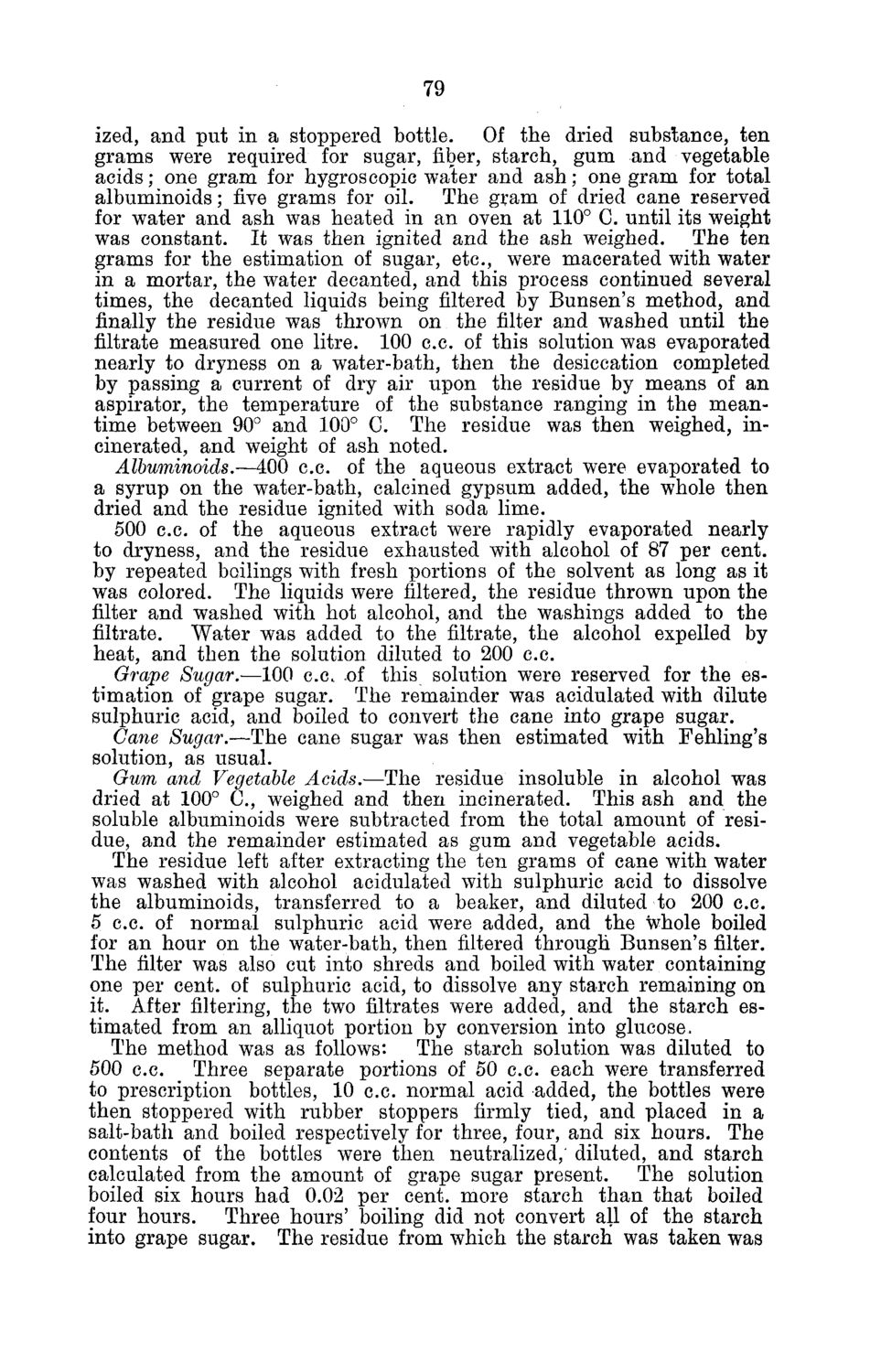| |
| |
Caption: Board of Trustees Minutes - 1882
This is a reduced-resolution page image for fast online browsing.

EXTRACTED TEXT FROM PAGE:
79 ized, and put in a stoppered bottle. Of the dried substance, ten grams were required for sugar, fiber, starch, gum and vegetable acids; one gram for hygroscopic water and ash; one gram for total albuminoids; five grams for oil. The gram of dried cane reserved for water and ash was heated in an oven at 110° C. until its weight was constant. It was then ignited and the ash weighed. The ten grams for the estimation of sugar, etc., were macerated with water in a mortar, the water decanted, and this process continued several times, the decanted liquids being filtered by Bunsen's method, and finally the residue was thrown on the filter and washed until the filtrate measured one litre. 100 c.c. of this solution was evaporated nearly to dryness on a water-bath, then the desiccation completed by passing a current of dry air upon the residue by means of an aspirator, the temperature of the substance ranging in the meantime between 90° and 100° C. The residue was then weighed, incinerated, and weight of ash noted. Albuminoids.—400 c.c. of the aqueous extract were evaporated to a syrup on the water-bath, calcined gypsum added, the whole then dried and the residue ignited with soda lime. 500 c.c. of the aqueous extract were rapidly evaporated nearly to dryness, and the residue exhausted with alcohol of 87 per cent, by repeated boilings with fresh portions of the solvent as long as it was colored. The liquids were filtered, the residue thrown upon the filter and washed with hot alcohol, and the washings added to the filtrate. Water was added to the filtrate, the alcohol expelled by heat, and then the solution diluted to 200 c.c. Grape Sugar.—100 c.c. of this solution were reserved for the estimation of grape sugar. The remainder was acidulated with dilute sulphuric acid, and boiled to convert the cane into grape sugar. Cane Sugar.—The cane sugar was then estimated with Fehling's solution, as usual. Gum and Vegetable Acids.—The residue insoluble in alcohol was dried at 100° C., weighed and then incinerated. This ash and the soluble albuminoids were subtracted from the total amount of residue, and the remainder estimated as gum and vegetable acids. The residue left after extracting the ten grams of cane with water was washed with alcohol acidulated with sulphuric acid to dissolve the albuminoids, transferred to a beaker, and diluted to 200 c.c. 5 c.c. of normal sulphuric acid were added, and the whole boiled for an hour on the water-bath, then filtered through Bunsen's filter. The filter was also cut into shreds and boiled with water containing one per cent, of sulphuric acid, to dissolve any starch remaining on it. After filtering, the two filtrates were added, and the starch estimated from an alliquot portion by conversion into glucose. The method was as follows: The starch solution was diluted to 500 c.c. Three separate portions of 50 c.c. each were transferred to prescription bottles, 10 c.c. normal acid added, the bottles were then stoppered with rubber stoppers firmly tied, and placed in a salt-bath and boiled respectively for three, four, and six hours. The contents of the bottles were then neutralized,' diluted, and starch calculated from the amount of grape sugar present. The solution boiled six hours had 0.02 per cent, more starch than that boiled four hours. Three hours' boiling did not convert all of the starch into grape sugar. The residue from which the starch was taken was
| |